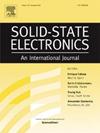基于3nm IRDS投影的无结叉片FET设计空间可变性和实验可行性:对下一代数字、模拟/RF和电路应用的影响
IF 1.4
4区 物理与天体物理
Q3 ENGINEERING, ELECTRICAL & ELECTRONIC
引用次数: 0
摘要
本文探讨了数字和模拟/RF优值(FOMs)以及电路性能,以寻找针对亚3nm技术节点的无结叉片FET (JL FS-FET)的最佳设计空间。在亚3nm节点内,栅极长度(Lg)、宽度(WFS)和厚度(TFS)分别在6 nm - 14 nm、20 nm - 40 nm和5 nm - 9 nm之间变化。对于sub- 3nm技术节点的数字和模拟/RF应用,可以选择Lg = 6 nm - 12 nm的最佳设计空间,Lg >; 12 nm的缩放不适合设计的jl - fset,因为它会导致Av和fT的恶化,而这是提高器件性能的主要性能指标。此外,降低WFS和TFS是提高数字和模拟性能的最佳选择,而在sub- 3nm技术节点中,应该选择更高的WFS和TFS以获得更好的射频性能。此外,以牺牲Av为代价来提高模拟/RF性能是一个好主意,而对于数字性能来说,这是一个不正确的选择。此外,基于jl - fset的CMOS逆变器布局单元的最佳尺寸(Lg = 12 nm, TFS = 5 nm, WFS = 20 nm)提供了更好的噪声裕度,增益为~ 9.82 V/V,延迟为~ 5.8 ps,使设计的器件可用于数字ic。这些发现表明,在sub- 3nm节点上的设计空间对于优化jl - fset性能具有重大潜力,可用于未来器件和电路的开发。本文章由计算机程序翻译,如有差异,请以英文原文为准。
A 3 nm IRDS projection based design space variability and experimental feasibility in junctionless forksheet FET: implications for next-generation digital, analog/RF, and circuit applications
This article explores the digital and analog/RF figures of merit (FOMs), and circuit performances for finding the optimal design space targeted at sub-3 nm technology node for the Junctionless Forksheet FET (JL FS-FET). Within the sub-3 nm node, the gate length (Lg), width (WFS), and thickness (TFS) are varied between 6 nm–14 nm, 20 nm–40 nm, and 5 nm–9 nm respectively. An optimal design space of Lg = 6 nm − 12 nm can be chosen for digital and analog/RF applications in the sub-3 nm technology node and scaling of Lg > 12 nm is not suitable for designed JL-FSFET since it gives deteriorated Av and fT which are the primary performance metrics to boost the device performance. Additionally, lowering the WFS and TFS is an optimal choice for improving the digital and analog performance whereas higher WFS and TFS should be opted for better RF performance in the sub-3 nm technology node. Moreover, stacking the sheets is a good idea to enhance the analog/RF performance at the cost of compromised Av whereas an improper choice for digital performance. Further, the JL-FSFET based CMOS inverter layout cell for the optimal dimensions (Lg = 12 nm, TFS = 5 nm, WFS = 20 nm) provided better noise margins, gain of ∼9.82 V/V, and delay of ∼5.8 ps making the designed device to be adopted into digital ICs. These findings suggest that design space at sub-3 nm node hold significant potential for optimizing JL-FSFET performance for future device and circuit development.
求助全文
通过发布文献求助,成功后即可免费获取论文全文。
去求助
来源期刊

Solid-state Electronics
物理-工程:电子与电气
CiteScore
3.00
自引率
5.90%
发文量
212
审稿时长
3 months
期刊介绍:
It is the aim of this journal to bring together in one publication outstanding papers reporting new and original work in the following areas: (1) applications of solid-state physics and technology to electronics and optoelectronics, including theory and device design; (2) optical, electrical, morphological characterization techniques and parameter extraction of devices; (3) fabrication of semiconductor devices, and also device-related materials growth, measurement and evaluation; (4) the physics and modeling of submicron and nanoscale microelectronic and optoelectronic devices, including processing, measurement, and performance evaluation; (5) applications of numerical methods to the modeling and simulation of solid-state devices and processes; and (6) nanoscale electronic and optoelectronic devices, photovoltaics, sensors, and MEMS based on semiconductor and alternative electronic materials; (7) synthesis and electrooptical properties of materials for novel devices.
 求助内容:
求助内容: 应助结果提醒方式:
应助结果提醒方式:


